Chem 104 experiment 1 - Study guides, Class notes & Summaries
Looking for the best study guides, study notes and summaries about Chem 104 experiment 1? On this page you'll find 24 study documents about Chem 104 experiment 1.
Page 2 out of 24 results
Sort by
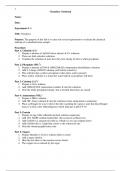
-
CHEM 104 Experiment 8: Urinalysis - Portage Learning
- Exam (elaborations) • 3 pages • 2023
- Available in package deal
-
- $13.49
- + learn more
CHEM 104 Experiment 8: Urinalysis - Portage Learning Purpose: The purpose of this lab is to carry out several experiments to evaluate the chemical makeup of a simulated urine sample. Procedure: Part 1: Chloride (Cl- ) 1. Prepare a mixture of AgNO3(silver nitrate) & Cl- solutions 2. These are both colorless solutions 3. Combine the solutions & note how they turn cloudy & form a white precipitate Part 2: Phosphate (PO3 -3) 1. Prepare a mixture of PO4 & (NH4)2MoO3 (Ammonium dimolybdate) solutions ...
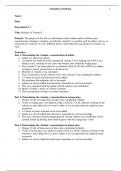
-
CHEM 104 Experiment 4: Molarity of Vitamin C - Portage Learning
- Exam (elaborations) • 3 pages • 2023
- Available in package deal
-
- $13.49
- + learn more
CHEM 104 Experiment 4: Molarity of Vitamin C - Portage Learning Purpose: The purpose of this lab is to determine a better understand of solutions and concentrations relating to vitamins, specifically vitamin C or ascorbic acid. In order to do so, we measured the vitamin C in a few different fruits to determine the concertation of vitamin c in each. Procedure: Part 1: Determining the vitamin c concentration of iodine 1. Iodine was placed in a buret. 2. A solution was made from the commercial vit...
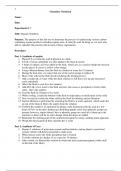
-
CHEM 104 Experiment 7 Organic Synthesis - Portage Learning
- Exam (elaborations) • 4 pages • 2023
- Available in package deal
-
- $14.49
- + learn more
CHEM 104 Experiment 7 Organic Synthesis - Portage Learning Purpose: The purpose of this lab was to determine the process of synthesizing various carboncontaining organic products including aspirin, urea, & salicylic acid. In doing so, we were also able to calculate the percent yield in each of these experiments. Procedure: Part 1: Synthesis of aspirin 1. Placed 2.0 g of salicylic acid & placed it in a flask 2. 5.0 mL of acetic anhydride was then added to the flask & mixed 3. 5 drops of sulfuric...
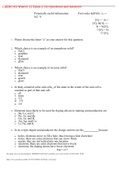
-
CHEM 102 Winter 12 Exam 2 (A) Questions and Answers,100% CORRECT
- Exam (elaborations) • 9 pages • 2023
-
- $14.99
- + learn more
CHEM 102 Winter 12 Exam 2 (A) Questions and Answers Potentially useful information: First order half-life: t1/2 = ln2 / k [A]t = - kt + [A]o ln[A]t = - kt + ln[A]o 1/[A]t = kt +1/[A]o 1. Please choose the letter “a” as your answer for this question. 2. Which choice is an example of an amorphous solid? a. NaCl b. graphite c. iron d. diamond e. glass 3. Which choice is an example of an ionic solid? a. NaCl b. diamond c. iron d. quartz e. glass 4. In body-centered cubi...
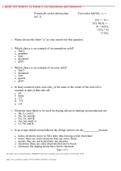
-
CHEM 102 Winter 12 Exam 2 (A) Questions and Answers,100% CORRECT
- Exam (elaborations) • 9 pages • 2023
-
- $14.99
- + learn more
CHEM 102 Winter 12 Exam 2 (A) Questions and Answers Potentially useful information: First order half-life: t1/2 = ln2 / k [A]t = - kt + [A]o ln[A]t = - kt + ln[A]o 1/[A]t = kt +1/[A]o 1. Please choose the letter “a” as your answer for this question. 2. Which choice is an example of an amorphous solid? a. NaCl b. graphite c. iron d. diamond e. glass 3. Which choice is an example of an ionic solid? a. NaCl b. diamond c. iron d. quartz e. glass 4. In body-centered cubi...

-
CHEM 102 Winter 18 Final Exam (A) Questions and Answers,100% CORRECT
- Exam (elaborations) • 19 pages • 2023
-
- $16.49
- + learn more
CHEM 102 Winter 18 Final Exam (A) Questions and Answers Potentially useful data: x 1 atm = 760 torr = 760 mm Hg 2 a [A]t = – kt + [A]o ΔG° = ΔH° – T ΔS° ln[A]t = – kt + ln[A]o ΔG = ΔG° + RT ln Q 1/[A]t = kt +1/[A]o ΔG° = – RT ln K First order half-life: t1/2 = ln2 / k ΔG° = – nFE° pH pKa log base acid E E R T ln Q n F R = 8.314 J mol-1 K-1 F = 96500 C/mol e- 1. Please choose the letter “A” as your a...

-
CHEM 102 Winter 18 Final Exam (A) Questions and Answers,100% CORRECT
- Exam (elaborations) • 19 pages • 2023
-
- $15.99
- + learn more
CHEM 102 Winter 18 Final Exam (A) Questions and Answers Potentially useful data: x 1 atm = 760 torr = 760 mm Hg 2 a [A]t = – kt + [A]o ΔG° = ΔH° – T ΔS° ln[A]t = – kt + ln[A]o ΔG = ΔG° + RT ln Q 1/[A]t = kt +1/[A]o ΔG° = – RT ln K First order half-life: t1/2 = ln2 / k ΔG° = – nFE° pH pKa log base acid E E R T ln Q n F R = 8.314 J mol-1 K-1 F = 96500 C/mol e- 1. Please choose the letter “A” as your a...
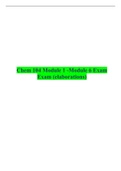
-
Chem 104 Module 1 -Module 6 Exam (elaborations)
- Exam (elaborations) • 32 pages • 2023
-
- $15.49
- + learn more
Chem 104 Module 1 -Module 6 Exam (elaborations) Module 1: Question 1 In the reaction of gaseous N2 O5 to yield NO2 gas and O2 gas as shown below, the following data table is obtained: 2 N2 O5 (g) → 4 NO2 (g) + O2 (g) Data Table #2 Time (sec) [N2 O5 ] [O2 ] 0 0.300 M 0 300 0.272 M 0.014 M 600 0.224 M 0.038 M 900 0.204 M 0.048 M 1200 0.186 M 0.057 M 1800 0.156 M 0.072 M 2400 0.134 M 0.083 M 3000 0.120 M 0.090 M 1. Using the [O2 ] data from the table, show the calculation of the instantaneous ra...
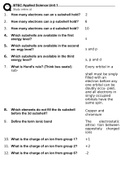

-
BTEC APPLIED SCIENCE: UNIT 11 - Learning Aim D
- Exam (elaborations) • 61 pages • 2023
-
- $13.49
- + learn more
1. How many electrons can an s subshell hold? 2 2. How many electrons can a p subshell hold? 6 3. How many electrons can a d subshell hold? 10 4. Which subshells are available in the first energy level? 5. Which subshells are available in the second en- ergy level? 6. Which subshells are available in the third energy level? s s and p s, p and d 7. What is Hund's rule? (Think bus seats!) Every orbital in a sub- shell must be singly filled with an electron before any one orbital can be d...
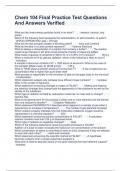
-
Chem 104 Final Practice Test Questions And Answers Verified
- Exam (elaborations) • 5 pages • 2024
-
- $11.49
- + learn more
Chem 104 Final Practice Test Questions And Answers Verified What are the three primary particles found in an atom? - electron, neutron, and proton Which of the following best represents the autoionization, or self-ionization, of water? - 2H2O(l) ARROW H3O+(aq) + OH-(aq) What are the two principal classes of bonding called? - Ionic and Covalent What do the dots in a Lewis symbol represent? - Valence Electrons What is always a characteristic of a solution that c...

Study stress? For sellers on Stuvia, these are actually golden times. KA-CHING! Earn from your study resources too and start uploading now. Discover all about earning on Stuvia


